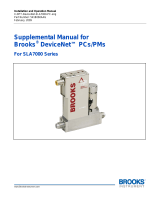
1.2.1. Safety Note
The voltage of the frequency converter is dangerous whenever connected to mains.
Incorrect installation of the motor, frequency converter or fieldbus may cause dam-
age to the equipment, serious personal injury or death. Consequently, the instruc-
tions in this manual, as well as national and local rules and safety regulations, must
be complied with.
1.2.2. Safety Regulations
1. The frequency converter must be disconnected from mains if repair work is to be carried
out. Check that the mains supply has been disconnected and that the necessary time has
passed before removing motor and mains plugs.
2. The [STOP/RESET] key on the control panel of the frequency converter does not dis-
connect the equipment from mains and is thus not to be used as a safety switch. 3.
Correct protective earthing of the equipment must be established, the user must be pro-
tected against supply voltage, and the motor must be protected against overload in
accordance with applicable national and local regulations.
3. Correct protective earthing of the equipment must be established, the user must be pro-
tected against supply voltage, and the motor must be protected against overload in
accordance with applicable national and local regulations.
4. The earth leakage currents are higher than 3.5 mA.
5. Protection against motor overload is not included in the factory setting. If this function
is desired, set par. 1-90
Motor Thermal Protection
to data value
ETR trip
or data value
ETR warning
. Note: The function is initialised at 1.16 x rated motor current and rated
motor frequency. For the North American market: The ETR functions provide class 20
motor overload protection in accordance with NEC.
6. Do not remove the plugs for the motor and mains supply while the frequency converter
is connected to mains. Check that the mains supply has been disconnected and that the
necessary time has passed before removing motor and mains plugs.
7. Please note that the frequency converter has more voltage inputs than L1, L2 and L3,
when load sharing (linking of DC intermediate circuit) and external 24 V DC have been
installed. Check that all voltage inputs have been disconnected and that the necessary
time has passed before commencing repair work.
1.2.3. Warning Against Unintended Start
1. The motor can be brought to a stop by means of digital commands, bus commands,
references or a local stop, while the frequency converter is connected to mains. If per-
sonal safety considerations make it necessary to ensure that no unintended start occurs,
these stop functions are not sufficient.
2. While parameters are being changed, the motor may start. Consequently, the stop key
[STOP/RESET] must always be activated; following which data can be modified.
3. A motor that has been stopped may start if faults occur in the electronics of the frequency
converter, or if a temporary overload or a fault in the supply mains or the motor con-
nection ceases.
1.2.4. Warning
Touching the electrical parts may be fatal - even after the equipment has been dis-
connected from mains.
1. Introduction FC 100/ 200/ 300 DeviceNet
6
MG.33.D3.02 - VLT
®
is a registered Danfoss trademark
1





















